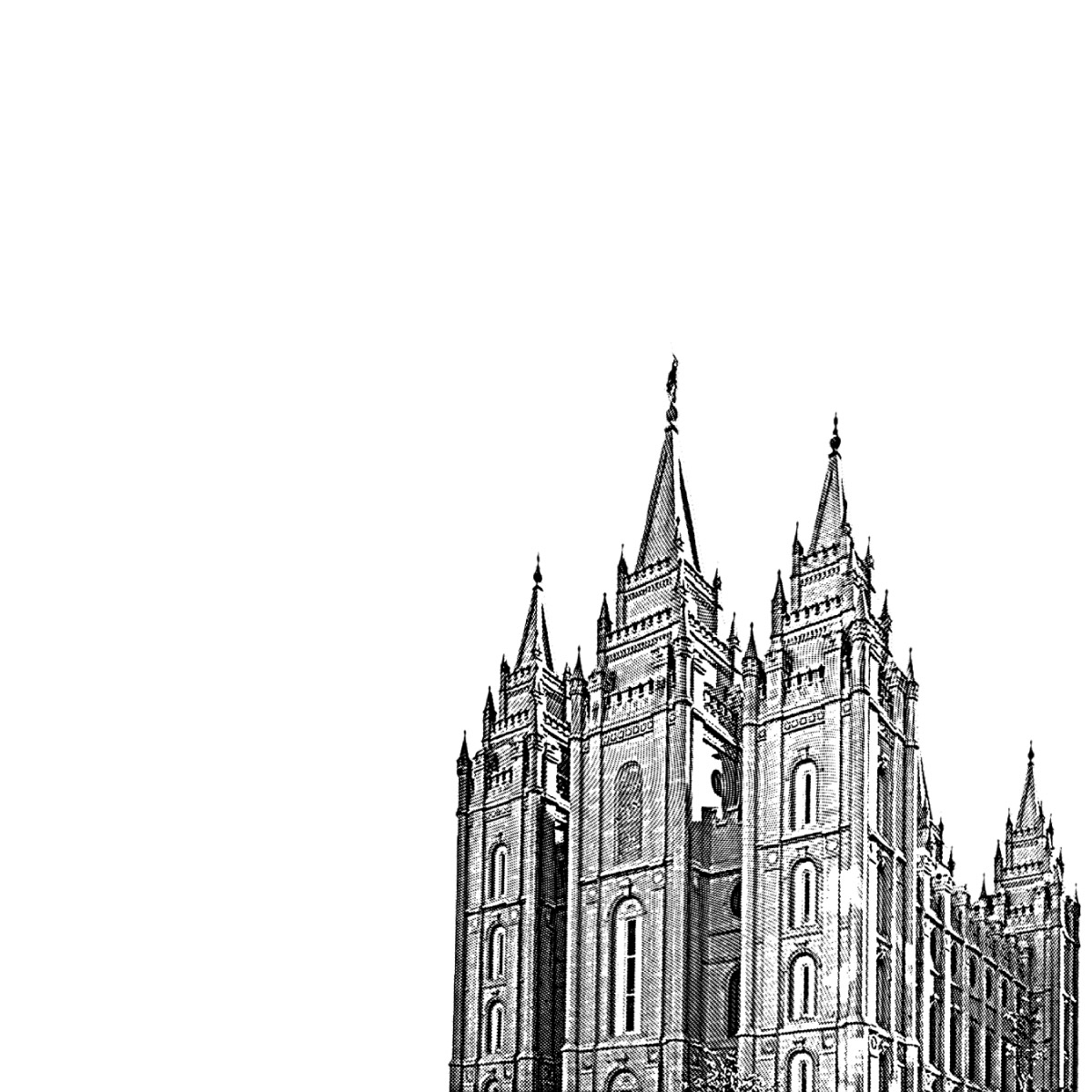Temple Garments

What are temple garments?
Temple garments are underclothes[1] that act as a reminder of covenants made in the temple.[2] They are white,[3] made from a variety of fabrics,[4] and have markings with spiritual significance.[5]
When were they “invented?”
According to Biblical tradition, the Lord made "garments of skins" for Adam[BIO] and Eve[BIO] after they were expelled from the Garden of Eden.[6]
The first historical record clearly referring to garments in modern times is from 1845.[7] However, Joseph Smith probably introduced them in 1842, around the same time he revealed the endowment.[8]
Who came up with the initial design?
It's unclear. There are no firsthand accounts of how Joseph Smith[BIO] arrived at the design of garments.
Did some early Church leaders teach that Jesus wears garments?
Possibly. There is one thirdhand account that claims Jesus wore garments in the First Vision.[9]There are some accounts from early Church leaders that reference Jesus and use the terms "garment" or "vesture," but it's unclear if this refers to temple garments or simply to clothing.[10][11]
Are there connections between garments and Freemasonry?
Yes. There are similarities between symbols on temple garments[12] and important Masonic symbols, including representations of the compass and square.[13]
What is the purpose of garments?
The Church Handbook states that the "garment is a reminder of covenants made in the temple. When members are faithful to their covenants and wear the garment properly throughout their lives, it also serves as a protection."[14]
Prophets and apostles have taught that the garment helps remind members of their temple covenants[15] and protect them from temptation.[16]
When we go through the temple, do we covenant to wear garments?
Not explicitly. The Church Handbook states that during the initiatory, members are "authorized" to wear garments[17] and those who receive the endowment "make a covenant to wear the temple garment throughout their lives."[18]
But do members of the Church make an explicit covenant in the temple about wearing garments?
No. However, an explicit covenant is also not made during the baptismal ordinance, but it is referred to as a covenant in scripture.[19]
Are garments supposed to protect people from physical harm?
Maybe? Some Church leaders and members believe this,[20] although the Church has never made an official statement related to this idea.
The idea that they may offer physical protection is a traditional belief that may originate from secondhand reports about Willard Richards[BIO] being protected in Carthage Jail because he was wearing temple garments. John Taylor,[BIO] Joseph, and Hyrum[BIO] were not wearing their garments and were injured and killed.[21]
But aren’t there stories about people being saved from danger by their garments?
Yes, there are stories about people being protected from physical harm,[22] but there are also instances of Church members and leaders who were injured or killed while wearing their garments.[23]
Did everyone in the early Church wear temple garments?
No. During Joseph Smith's time, only a relatively small number of people received temple ordinances and wore garments.[24] After Joseph Smith was killed in 1844 and the Saints prepared to leave Nauvoo, more Latter-day Saints received their endowments in the Nauvoo Temple and wore garments.[25]
How were they made?
Women in the Relief Society sewed garments and temple robes by hand, teaching the design to other sisters.[26]
Don't garments just control sexuality and modesty?
Yes, in some ways. Their primary purpose is to act as a reminder of the covenants made in the temple,[27] including a covenant related to the law of chastity.[28] Garments aren't designed to be particularly attractive,[29] so it's possible they discourage sexual activity.
Related Question
Does the Church restrict the bodily autonomy or reproductive rights of women?
Read more in Abortion
Do you have to wear your garments all the time?
Probably. Instructions on temple garments included in temple recommend interviews state that garments should be worn "throughout life," including “for activities that can reasonably be done while wearing [them].”[30]
However, the temple interview question about wearing garments "both day and night" was updated[31] in 2020 to simply ask if temple garments were worn "as instructed in the endowment."[32]
In 2022, President Kevin W. Pearson of the Utah Area Presidency stated in a Utah Area broadcast, "we are dismayed by the casual and even cavalier way some treat their temple covenants, including the casual and inconsistent wearing of the temple garment."[33]
Did the Church ever teach that you had to wear your garments when you had sex with your spouse?
No. The Church teaches that garments may be removed for "purposes requiring the baring of body."[34]
However, this idea is sometimes found in the media or in material critical toward the Church.[35]
Do other religions have anything like temple garments?
Yes. It's not uncommon for religions to have clothing that reflects their religious tenets.[36] Sikhs[37] and Zoroastrians both wear sacred underclothing.[38] Many Orthodox Jewish men wear yarmulkes[39] and a tallit katan[40] and some Orthodox Jewish women wear wigs.[41] Some Buddhist monks wear robes.[42] Some Catholic nuns wear habits[43] and some monks wear cassocks.[44]
Is it true that you could buy temple garments at JCPenney in Utah back in the day?
Yes. Members of the Church could buy garments at many retail stores in Utah up until the 1970s.[45] By 1977, the Relief Society had acquired the exclusive rights to distribute temple garments.[46]

Have the garments been changed? Could they change again?
Yes and possibly. The garment cut and style have changed many times over the last century (see below).
Year | Changes Made |
1923 | The Church authorized the change of the garment from ankle-length to knee-length and from wrist-length to short sleeves.[47] Members were also told they could remove the collars and replace string-up attire with buttons.[48] |
1979 | Garments changed from a one-piece to a two-piece.[49] |
2018 | The Church discontinued certain fabrics and styles while also announcing stretch cotton garments.[50] |
2019 | The women's stretch cotton garment line was extended.[51] |
2024 | The Church approves sleeveless tops, skirt bottoms, and one-piece shift dress garments for members living in hot, humid climates, such as Africa and the Philippines as well as "others who might benefit from the changes."[52] |
Were the changes because of modern fashion changes?
Yes, probably. The garments have changed over time along with general fashion trends.[53] However, the symbols in the garments have remained the same.[54]
Related Question
Does Utah have one of the highest rates of cosmetic surgery in the country?
Read more in Cosmetic Surgery in Utah
Aren’t garments really uncomfortable, especially for women?
Some women reportedly find them uncomfortable,[55] others do not.[56]
Are you allowed to wear “regular” underwear under your garments?
Yes. In 2019, the Church clarified that it's acceptable to wear garments over regular underwear.[57] For example, women may choose to wear garment tops over bras.
Are members allowed to talk about garments with non-Latter-day Saint people?
Yes. When Mitt Romney[BIO] ran for U.S. president in 2008 and 2012, many people became curious about garments.[58] In 2014, the Church released an informational video explaining the purpose of the garments.[59]
- Evan P.
“Garments are a blessing and not a restriction. I am grateful for their representation as well as the spiritual power and protection they have brought into my life and the lives of those in my family.” - Julie T.
“I’ve not always understood the garment in my 19+ years of wearing them but have come to love what they represent. I find the changes very welcoming as a woman.” - Sharon B.
“I feel safe and comforted when wearing my garments, I feel odd if NOT wearing them. I feel closer to my Savior as well.” - Jedd O.
“The garmet has provided Spiritual and Physical protection to myself. However, We have agency and must be obedient to the spiritual laws or commandments in order for the garment to provide the blessings intended.” - M. L. S.
“Wearing the garments has given me a constant reminder of my temple covenants. I feel safe and protected while I wear the garments. From this article and other sources of learning, I have come to know the importance of wearing the temple garments.”



 about this topic
about this topic